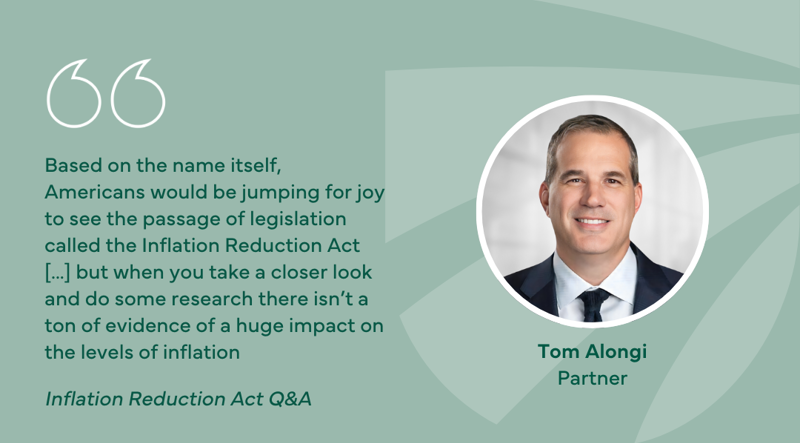Thomas Alongi, national manufacturing & automotive practice leader, shares his initial reaction to the proposed Inflation Reduction Act of 2022.
Q: Tom, as the leader of both the national manufacturing practice and automotive practice at UHY, what are your initial thoughts on the Inflation Reduction Act of 2022?
Tom: On the surface, and based on the name itself, Americans would be jumping for joy to see the passage of legislation called the Inflation Reduction Act with how everything has been going and record-setting levels of inflation, but when you take a closer look and do some research there isn’t a ton of evidence of a huge impact on the levels of inflation. Putting the name of the bill aside, there is some real substance, and certainly winners and losers in the bill. About 150-200 of the largest established corporations will bear a tax increase, while “green” initiatives will receive the benefits. Companies investing in green energy facilities, solar, wind, utilities, EV battery plants, and manufacturers supplying these investments should see opportunities. However, the impact and return on these investments will take years to play out.
Q: What sort of overall impact do you see this having on middle market manufacturers?
Tom: First and foremost, we see a 15% “book minimum tax” on the largest corporations in the US, with average income greater than $1 billion. From everything I have read, early estimates state the manufacturing industry would be responsible for a significant portion of the close to $300 billion in tax revenue generated by this tax.
Q: Is it a bad thing for these mega corporations to pay an additional 15% in taxes?
Tom: Although certain large corporations and manufacturers will be DIRECTLY impacted, in the end, these large corporations won’t be the only ones that will endure some of the pain. When corporations are taxed, they indirectly pass the burden on by potentially doing less business with their vendors, cutting R&D, reducing their workforce, finding ways to become more efficient, or passing on price increases if possible. These corporations need to find ways to compete on a global scale, and tax increases can be one element that can make them less competitive. However, on the other side, with such a substantial investment in green technologies, many “green” companies and their supply base will likely see increased opportunities, like equipment suppliers, advanced technology companies, and other industrial suppliers supporting green initiatives.
Q: What is a key provision that might have a positive impact on middle market manufacturing companies?
Tom: A provision of interest is a new Section 45X credit which provides for a credit to a qualifying component produced within the U.S. Eligible components include finished equipment and component parts for wind power, generation facilities, solar generation facilities, inverter equipment, and energy storage equipment. We will have to see how all the details play out, but this credit could provide manufacturers an opportunity to offset some of the higher costs associated with manufacturing in the U.S.
Q: Wow, I don’t think most people will realize how far reaching the impact would be by just reading the cliff notes of the bill. What else within the bill should manufacturers be aware of?
Tom: It’s a little more loaded than people think. A couple of other items are the fact that one of the hottest topics we always talk about is skilled labor, but this bill on the surface makes no real significant investment in technical training, and next generation work force that is so critical in advanced manufacturing. It’s a massive reallocation of capital from established companies employing millions of workers, to new green energy projects, but is the workforce there to support the shift?
Q: Do you see a big benefit to U.S. automakers and consumers?
Tom: Yes, automakers overall are winners as they look to capitalize on credits and incentives for battery plant facilities. In addition, consumers will see an expansion of the $7,500 EV credit and $4,000 for used EV credit. Currently, very few EV’s if any would meet the requirements to qualify for the new EV credit due to the maximum price of $55,000, and income limitations, but as new lower cost vehicles roll out over the next several years there should be a positive impact for consumers provided, they can get their hands on some of these hot new EV’s coming to market.
Q: Thanks for that insight, Tom. Any final thoughts on this legislation?
Tom: Obviously, we will have to start investing in greener tech to reduce our overall carbon emissions, and this bill gives us for all intents and purposes at least a jump start into these “green “initiatives.
Alongi will host the UHY Automotive Outlook on September 15 at Detroit Athletic Club and via livestream where he will address these topics and many more surrounding the automotive industry.
Have a Question?
Please complete this form to hear from our innovative manufacturing professionals
By submitting this form, you agree to be contacted by UHY.







